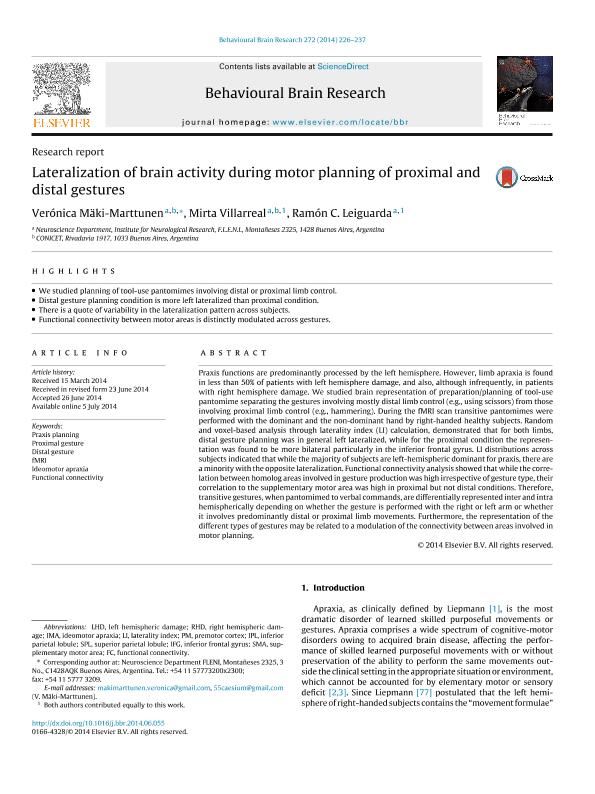Mostrar el registro sencillo del ítem
dc.contributor.author
Mäki Marttunen, Verónica
dc.contributor.author
Villarreal, Mirta Fabiana

dc.contributor.author
Leiguarda, Ramón Carlos

dc.date.available
2018-02-15T13:58:08Z
dc.date.issued
2014-10
dc.identifier.citation
Mäki Marttunen, Verónica; Villarreal, Mirta Fabiana; Leiguarda, Ramón Carlos; Lateralization of brain activity during motor planning of proximal and distal gestures; Elsevier Science; Behavioural Brain Research; 272; 10-2014; 226-237
dc.identifier.issn
0166-4328
dc.identifier.uri
http://hdl.handle.net/11336/36503
dc.description.abstract
Praxis functions are predominantly processed by the left hemisphere. However, limb apraxia is found in less than 50% of patients with left hemisphere damage, and also, although infrequently, in patients with right hemisphere damage. We studied brain representation of preparation/planning of tool-use pantomime separating the gestures involving mostly distal limb control (e.g., using scissors) from those involving proximal limb control (e.g., hammering). During the fMRI scan transitive pantomimes were performed with the dominant and the non-dominant hand by right-handed healthy subjects. Random and voxel-based analysis through laterality index (LI) calculation, demonstrated that for both limbs, distal gesture planning was in general left lateralized, while for the proximal condition the representation was found to be more bilateral particularly in the inferior frontal gyrus. LI distributions across subjects indicated that while the majority of subjects are left-hemispheric dominant for praxis, there are a minority with the opposite lateralization. Functional connectivity analysis showed that while the correlation between homolog areas involved in gesture production was high irrespective of gesture type, their correlation to the supplementary motor area was high in proximal but not distal conditions. Therefore, transitive gestures, when pantomimed to verbal commands, are differentially represented inter and intra hemispherically depending on whether the gesture is performed with the right or left arm or whether it involves predominantly distal or proximal limb movements. Furthermore, the representation of the different types of gestures may be related to a modulation of the connectivity between areas involved in motor planning.
dc.format
application/pdf
dc.language.iso
eng
dc.publisher
Elsevier Science

dc.rights
info:eu-repo/semantics/openAccess
dc.rights.uri
https://creativecommons.org/licenses/by-nc-sa/2.5/ar/
dc.subject
Distal Gesture
dc.subject
Fmri
dc.subject
Functional Connectivity
dc.subject
Ideomotor Apraxia
dc.subject
Praxis Planning
dc.subject
Proximal Gesture
dc.subject.classification
Neurociencias

dc.subject.classification
Medicina Básica

dc.subject.classification
CIENCIAS MÉDICAS Y DE LA SALUD

dc.title
Lateralization of brain activity during motor planning of proximal and distal gestures
dc.type
info:eu-repo/semantics/article
dc.type
info:ar-repo/semantics/artículo
dc.type
info:eu-repo/semantics/publishedVersion
dc.date.updated
2018-02-14T19:28:11Z
dc.journal.volume
272
dc.journal.pagination
226-237
dc.journal.pais
Países Bajos

dc.journal.ciudad
Amsterdam
dc.description.fil
Fil: Mäki Marttunen, Verónica. Consejo Nacional de Investigaciones Científicas y Técnicas; Argentina. Fundación para la Lucha contra las Enfermedades Neurológicas de la Infancia; Argentina
dc.description.fil
Fil: Villarreal, Mirta Fabiana. Fundación para la Lucha contra las Enfermedades Neurológicas de la Infancia; Argentina. Consejo Nacional de Investigaciones Científicas y Técnicas; Argentina
dc.description.fil
Fil: Leiguarda, Ramón Carlos. Fundación para la Lucha contra las Enfermedades Neurológicas de la Infancia; Argentina
dc.journal.title
Behavioural Brain Research

dc.relation.alternativeid
info:eu-repo/semantics/altIdentifier/doi/http://dx.doi.org/10.1016/j.bbr.2014.06.055
dc.relation.alternativeid
info:eu-repo/semantics/altIdentifier/url/https://www.sciencedirect.com/science/article/pii/S0166432814004380
Archivos asociados
